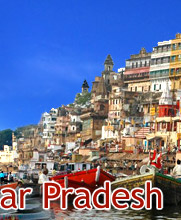 Dhamek
Stupa in Sarnath is one of the most visited and most revered Buddhist
Shrines in the world. Dhamek Stupa marks the place where Lord Buddha
gave away his first sermon after he got enlightened in Bodh Gaya. Dhamek
Stupa is arguably the most remarkable structure at Sarnath. Typical of
Stupas of that period, Dhamek is cylindrical in shape with a base that
is more than 28 meters in diameter. The Stupa stands 31.3 meters above
the pedestal whereas the entrance measures 43.6 meters on its feet.
Dhamek Stupa that was originally commissioned during Mauryan period is
made partly out of red bricks and stones.
Dhamek
Stupa in Sarnath is one of the most visited and most revered Buddhist
Shrines in the world. Dhamek Stupa marks the place where Lord Buddha
gave away his first sermon after he got enlightened in Bodh Gaya. Dhamek
Stupa is arguably the most remarkable structure at Sarnath. Typical of
Stupas of that period, Dhamek is cylindrical in shape with a base that
is more than 28 meters in diameter. The Stupa stands 31.3 meters above
the pedestal whereas the entrance measures 43.6 meters on its feet.
Dhamek Stupa that was originally commissioned during Mauryan period is
made partly out of red bricks and stones. The architectural pattern of Dhamek Stupa is distinct in itself. Numerous excavation works have been carried out in and around this structure that was first started by Colonel Cunningham of Royal British Army in early 20th century. The decorative patterns on the trunk of Stupa are mesmerizing. Panels that are carved with geometric and floral designs mark the trunk of Dhamek Stupa. The design also consists of a broad band of Swastika (fylfot). These Swastikas have been carved in different geometrical patterns with a finely chiseled lotus wreath, running over and below it. It has also been reveled that the structure was expanded and enlarged as many as 12 times in the course of history. It is interesting to note that successive patrons of this shrine have each added and embellished the original shrine. The main area has been enclosed and consists of a labyrinth of half-ruined monasteries and votive Stupas.
It can be safely claimed that Dhamek Stupa is the most conspicuous structure at Sarnath. During the initial excavation, a stone tablet was unearthed that reveled that the name of this Stupa is Dhamek and it marks the place where Lord Buddha gave his first sermon. It is generally agreed upon by the historians that the word Dhamek is a distorted form of Dharma Chakra that means turning the wheel of the Dharma. Some also claim, with the help of Prakrit sources that Dhamek is the very spot where the five ascetics who left Gautam Buddha in Bodh Gaya used to live in huts.
Several dignitaries as well as other pilgrims of Buddhist countries visit this place for circumambulation of this sacred Stupa. The pattern of worship followed by the Tibetans is different from other Buddhists. Tibetans Buddhist circumambulates Stupa counter-clockwise chanting the mantra 'Om mani padme hum'. It is worth knowing that the first discourse of the Buddha was on the 'Wheel of Law'. This is the possible reasoning behind the naming of this Stupa.









